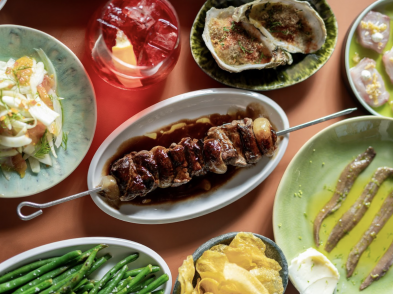Would you recognize a chicory if you saw one? Chances are that many of you would not. And yet chicory stalks in our midst. It has been stalking in our midst since antiquity.
A few months ago I probably wouldn’t have recognized a chicory either. After hearing the word over and over again, I looked it up in the Oxford English dictionary. There I read that it was a plant with blue flowers growing by road sides and that its root was roasted and ground as a coffee substitute. I couldn’t make that fit my vague idea of what chicory was all about. My German-English dictionary didn’t even accord it the plant symbol given to every other botanical name in the dictionary. I delved into my library of cookbooks, hoping that Marcella Hazan would have some bright ideas for serving it. In vain! And not even the great Artusi mentions it. For some strange reason, cooks have been ignoring chicory for years.
Chicory is very real and present just now. Go to the market and you’ll see one chicory after another waving its leaves at you. You can’t take a step without encountering chicory. The name chichory (from Chicorium intybus) is an umbrella for a whole range of leafy vegetables, green or red, slim or round, long or short. They are commonly called puntarelle, radicchio and (the one I’ll bet you know) Belgian endive. Scarola, or escarole, is a cousin of theirs. All these developed from that blue flower wild plant mentioned by the OED.
Their nutritious qualities and their versatility are remarkable. They are full of sodium, potassium, calcium and phosphorus, not to mention vitamins B and C. They are easy to digest. They can be eaten raw or cooked. The flavour they all have in common is a slight, but pleasant, bitterness.
The modern Romans have turned punterelle salad into one of their classic early springtime specialties. Puntarelle is a type of chicory known as Catalonia, with long, green spiked leaves and a cluster of thick shoots at the bottom, like a lot of pointed green thumbs. Cut the shoots off the main stalk and slice them in very narrow strips. Throw them into a bowl of iced water to make them curl in the most intriguing way. Dress with anchovies, garlic, salt and olive oil, in the proportions you like best.
Puntarelle are also delicious cooked, as I discovered one very cold day. I’d been to the market and bought a splendid specimen, full of green shoots, but the freezing weather made me long for something hot instead of a cold salad. Since I had nothing else in the house, I decided to sacrifice the puntarelle. I trimmed off the shoots, quartered them lengthwise and threw them into a wok with some olive oil and salt. After stirring them for a few minutes, I tossed in the more delicate leaves, which I’d already torn into smaller pieces.
Since I ended up with more cooked puntarelle than I could eat in one meal, I decided to try the leftovers as the condiment for pasta the next day. I got a soft, fresh salsiccia from the butcher, removed the casing, crumbled the sausage meat into a pan and let it cook in its own juices (if you add olive oil, the sausage will fry, so it’s best to let the fat in the sausage melt over a low-to-medium heat). When the sausage meat was done, I threw in the puntarelle from the day before, which I had cut into smaller pieces to mix better with the pasta. The flavour was superb, the slightly bitter nip of the puntarelle keeping the spicy and slightly fatty sausage meat from overpowering the dish.
Radicchio, too, is a superb addition to risotto and pasta dishes. The authentic—and best—radicchio is grown in the Veneto, where, according to some, it arrived from the Orient in the fifteenth century and was being cultivated in Treviso by the sixteenth century. The different types of radicchio are named after various Venetian provinces: Chioggia (the most common, as round as a small cabbage), Verona (shaped like a big fist), variegated Castelfranco (broad and delicate pale green leaves with red veins), early Treviso (looks like an elongated Verona), and late Treviso (the most expensive of them all, has very thin leaves that end with a curl). Castelfranco and Chioggia are excellent for salads and the others are best adapted for cooking, though all lend themselves to both modes of preparation. The Italians love to grill radicchio, which tastes exquisite with a drop of olive oil and half a drop of balsamic vinegar.
If you want to serve radicchio with pasta, stir fry it, torn or cut into strips, with either anchovies, bacon, or crumbled sausage meat (as described above), or even leftover ham. Don’t use salt because the fish and meat are both very salty already. Walnuts or pine nuts are delicious, added right at the beginning of the cooking process. Sweet black olives, too, are an excellent addition. Combine with short pasta or potato gnocchi.







